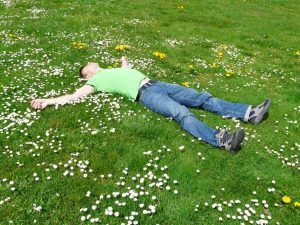9. My Secret Weapon: Pre-Emptive Rest
Table of Contents
 When I was first ill, I often experienced the cycle of push and crash, swinging back and forth from too much activity to periods of rest. I would be more active than my body could tolerate, experience intense symptoms, and then use rest to recover. Spending a few hours, a whole day or sometimes several days in bed was an effective strategy for recovering from periods of doing too much, but a frustrating way to live. The experience motivated me to find a different way to live with CFS.
When I was first ill, I often experienced the cycle of push and crash, swinging back and forth from too much activity to periods of rest. I would be more active than my body could tolerate, experience intense symptoms, and then use rest to recover. Spending a few hours, a whole day or sometimes several days in bed was an effective strategy for recovering from periods of doing too much, but a frustrating way to live. The experience motivated me to find a different way to live with CFS.
About nine months after becoming ill, I learned that I could use rest for another reason besides recuperation. I found that rest could actually prevent symptoms. This idea was one of the strategies recommended by CFS researchers in England who counseled patients to live their lives according to a plan, one which included similar amounts of activity each day and also daily scheduled rest periods. The goal was to shift away from living in response to symptoms (the cycle of push and crash) toward a consistent, planned life.
I was attracted to the idea of gaining control over the swings in my symptoms and I could accept the idea that a similar amount of activity each day could help me achieve greater predictability. But I resisted the idea of resting each day regardless of how I felt. I couldn’t understand why I would lie down voluntarily, even if my symptoms hadn’t worsened. Also, I thought of resting as giving in to the illness, so that rest meant a victory for the illness.
Rest = Lying Down, Eyes Closed
Because other parts of the program from England made sense, I decided to try resting every afternoon. After some experimentation, I determined that the most restorative rest resulted from lying down in a quiet place with my eyes closed.
I was surprised at the results from taking a 15-minute rest in mid-afternoon. Even that short break seemed to help, reducing my symptoms, increasing my stamina and making my life more stable. After a while I added a similar rest in late morning.
Over time, I came to believe that my scheduled rest was the most important strategy I used in my recovery. Resting everyday according to a fixed schedule, not just when I felt sick or tired, was part of a shift from living in response to symptoms to living a planned life. The experience showed me that rest could be used for more than recovering from doing too much; it could be employed as a preventive measure as well. In the terms suggested by someone in our self-help program, I learned the difference between recuperative rest and pre-emptive rest.
Surprisingly, taking pre-emptive rests greatly reduced the time I spent in recuperative rest, because I was experiencing much less Post-Exertional Malaise. The result was that my total rest time was reduced.
Rest + Relaxation
I found that my rests were even more effective after I started doing a relaxation practice at the same time. Without the mental relaxation, my mind could race from worry to worry, so I experimented with various meditation procedures during my rest time. I found that focusing my attention on my breathing was the most effective technique for me. By lying down and keeping my awareness on my breath, I could relax both physically and mentally.
I applied the idea of planned rests in other parts of my recovery. For example, I used it to expand my envelope for travel. I found that if I stopped during driving trips for a ten- to 15-minute rest every two hours (tilting the seat back, putting on a sleep mask), I arrived fresher at my destination and had a lower symptom level throughout my trip. Also, as I will explain in more detail in the chapter on exercise, I was able to extend greatly the distance I walked if I alternated walking with sitting down: walk, rest, walk, rest.
The principle I learned from all these experiments was that rest could have a dramatic effect on the energy available to me and on my symptom level. Taking a short rest break to re-charge my batteries expanded the number of productive hours in my day. Also, I found that I could avoid a long period of bed rest by taking a brief rest as soon I felt my symptoms beginning to get worse.
As I improved to 90% and beyond, I gradually phased out pre-emptive rests, but for four years planned rest was crucial. It both reduced my total rest time and helped bring stability back into my life, a big payoff for two brief breaks in my day.